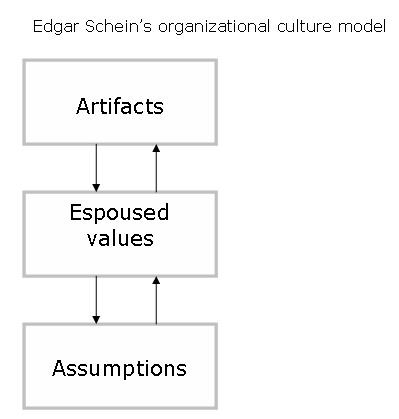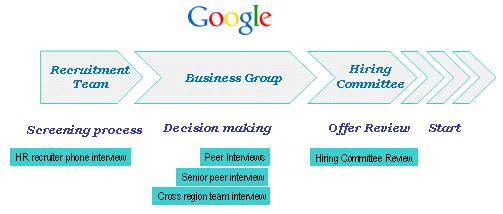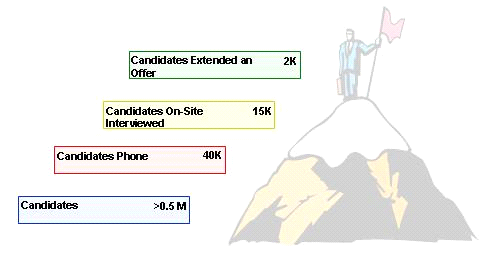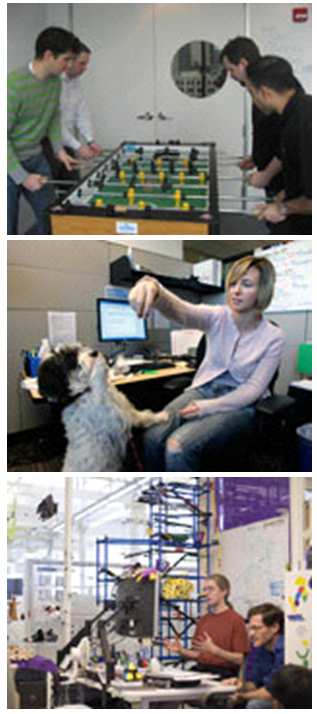-
Paper Information
- Previous Paper
- Paper Submission
-
Journal Information
- About This Journal
- Editorial Board
- Current Issue
- Archive
- Author Guidelines
- Contact Us
Management
p-ISSN: 2162-9374 e-ISSN: 2162-8416
2014; 4(4): 98-101
doi:10.5923/j.mm.20140404.03
A Evaluation of Google’s Organisational & Recruitment Culture
Yusuf Ali Kausar Rushdi1, Asma Nasir Kamal2
1Kensington College of Business, University of Wales, Glasgow, UK
2General Practice, Glasgow, United Kingdom
Correspondence to: Yusuf Ali Kausar Rushdi, Kensington College of Business, University of Wales, Glasgow, UK.
| Email: |  |
Copyright © 2014 Scientific & Academic Publishing. All Rights Reserved.
“A new idea to prepare a universal search engine which could connect with other websites around the globe” - Google. Google is the world leader in recruiting culture and has the world’s largest recruiting budget. Its organisational culture is people centred & knowledge driven with a 7- 20 -10 framework. This culture has many benefits for its employees like flexible hours, free meals etc. Google’s culture has been structured with two main dimensions that are a ‘physical object’ and a ‘behaviour pattern’. But due to the informal culture it adoptsit is noticed that there is an absence of a clear management structure, poor employee relations and work ethics.
Keywords: Organisational culture, Business model, Framework, Assumptions, Recruitment
Cite this paper: Yusuf Ali Kausar Rushdi, Asma Nasir Kamal, A Evaluation of Google’s Organisational & Recruitment Culture, Management, Vol. 4 No. 4, 2014, pp. 98-101. doi: 10.5923/j.mm.20140404.03.
Article Outline
1. Introduction
- Organization culture is gaining prominence in the modern business world. Most business establishments are keenly developing and nurturing a culture that suits their organizational objectives and facilitate future growth prospects. Organizational culture has been recognized as one of the important factors in the long-term success of an organization. According to Schein (1990), “Organizational culture is a pattern of shared basic assumptions that the group learned as it solved its problems of external adaptation and internal integration, that has worked well enough to be considered valid and therefore, to be taught to new members as the correct way to perceive, think, and feel in relation to those problems” (Serrat 2009).
2. Main Body
- Google is thought to be one of the most flourishing web-based companies, which has successfully blended technology innovation with a strong organizational culture. It is believed that its culture and values are represented in their main spirit, beliefs, assumptions, attitudes and performance highlighting an “informal culture”. The organisation is essentially a people-centred, knowledge-driven company operating several offices worldwide. Employees are the most important factor in the Google’s business model, and hence, it has given priority tonurture and develop a work culture that is conducive to its long-term business objectives. Another aspect of Google’s organizational culture is that it emanates from people who are highly qualified and objective oriented. As a result, its organizational culture has imbibed certain unique qualities, which are found nowhere else such as 70-20-10-work framework, generous employee reward system and a high level of employee empowerment. All of these factors have differentiated Google’s organizational culture from the traditional style of command and control widely seen in the business world. The Google culture can be classified according to Edgar Schein’s three level models (Schein 2004) and is structured with two main dimensions that is ‘physical object’ and ‘behaviour pattern’. Physical objects include the working environment and amenities to employees whereas behaviour pattern signifies respect, equality, commitment, teamwork, youth orientation and personal development. The Edgar Schein’s three level model is outlined below (Fig 1).
 | Figure 1. Culture model |
2.1. Factors Governing Recruitment
- Several factors, both external and internal, can affect recruitment (Knol 2009). External factors such as supply and demand of the labour market and the current unemployment rate affect the recruitment of any organisation. The political and social environment including the image of the organisation can also affect its recruitment. Internal forces affecting recruitment include the company’s policy for recruitment, cost, the size of the firm and its current state of growth and expansion.The following sections analyse Google’s recruitment and selection policies.
2.2. Strategic “Disruptive Recruiting”
- Certain technology (such as Apple’s iPod) which have drastically changed the entire technology and entertainment marketplace are termed “disruptive technology.” Google has created the same phenomenon in the form of a “disruptive approach” to work and recruitment, an approach so different and compelling through which it attains the very best of employees (Sullivan 2005).
2.3. Recruiting Culture
- Over the course of a few years, Google has developed a form of a “recruiting machine.” Google does not occupy the first position for best sales and marketing strategy (a position occupied by FirstMerit Bank), nor is it thought to be the best in the use of metrics (like Valero Energy), but it is renowned for developing the world’s first “recruiting culture”. This implies that all the employees in various positions in the hierarchy are involved in the recruitment process. Google not only funds recruitment policies to a large extent but has also changed the way that employees function and aims to attract and recruit the very best (Sullivan 2005).
2.4. “20% Time”
- Google’s founders, HR director (Stacy Sullivan), and its leadership team have strived to outline each position and its role in the workplace in order to ensure that employees are interested in their work and are continuously challenged to do more thereby facilitating their learning process and development of the feeling that they are contributing effectively. This idea of changing work so that it becomes a vital force driving innovation and motivation, as well as attracting employees and maintaining their satisfaction has evolved into the concept termed “20% work.” This involves the employee being given one day a week where they can work on their own and research individually selected projects, which are funded and supported by the company. This serves to encourage creativity, enthusiasm and innovation among all employees of the company. (Sullivan 2005).Google has the World’s Largest Recruiting Budget and is reported to have 1 recruiting staff member for every 14 employees. (Sullivan 2005). The benefits offered to employees are designed to encourage collaboration, to break down barriers between functions, and to stimulate individual creativity and innovation. Some of these unique benefits include the option of working flexible hours, access to an on-site physician, free massage and yoga, free meals, valet parking and good packages for maternity and parental leave.Google hires like-minded candidates who share their values and goals. They aim to maintain a work/life balance, which benefits both its employees and the organisation.The ideal candidate at Google should be ethical, enthusiastic, and talented. The candidate should possess strong analytical skills and they should be passionate, innovative with a solution-oriented mindset. Google aims to employ self-motivated individuals who can also communicate openly and clearly.
2.5. Google’s Interviewing Criteria (Li 2008)
- Google has certain criteria for assessing potential applicants and their desirable and undesirable qualities are discussed in this section. Qualities that are considered desirable include the possession of skills and qualifications that would enable the candidate to bring knowledge to the work environment. Those candidates that are innovative and inspirational team-workers, focussed on attaining their goals and getting the tasks completed, who will add value to the organisation are considered ideal for Google.On the other hand, those applicants who like to work alone, who would not be a contributing and actively participating member of a team, who would not be able to impart knowledge or challenge others would not be able to fit in to Google’s culture and would not be considered.Google’s recruiting process has four stages. The first stage involves screening of applicants via the HR department followed by the second stage during which a series of peer interviews are conducted, applicants are assessed and decisions regarding recruitment are made. The hiring committee then reviews all the candidates and provides them with a recruitment offer. Stage four involves the commencement of the job by the employee. Google’s recruitment policies are quite strict, as they only want the best. More than half a million prospective applicants apply online, 40,000 apply through the phone, 15,000 on site, but only 2,000 are actually recruited. Google is reported to receive greater than one million job applications every year, and has a small voluntary turnover rate of 4.3% (Logan 2008).
 | Figure 2. Four Stages of Google's Recruiting Process (Li 2008) |
 | Figure 3. Process Statistics & Candidate Experience (Li 2008) |
2.6. Google's Recruitment Strategy Revealed
- Liane Hornsey of Google quotes that the organisation is “built on trust”. She has said that, 'We try very hard to find the right people, people who will fit in with the Google culture, because we believe that if you can hire the right people, then everything else just flows from that,' (Google 2008 ). She also stated that Google stresses the importance of hiring the right employees to the extent that it would wait long periods of time and interview several applicants in order to find the right candidate. (Logan 2008). Additionally, she mentioned that Google only expects employees to work hard for approximately 70% of the time and operates a policy of unlimited sick leave.It has been observed that Google places great emphasis on its recruitment culture as it believes the right candidates will be able to uphold the policies and culture of the organisation.
 | Figure 4. Life at Google |
3. Conclusions
- Google is a flat organization with a lack of hierarchy and has a team-oriented and collaborative culture that encourages employees to think non-traditionally. Google recruits “Google-y” employees, who are flexible, innovative individuals who focus on getting the work done. They treat their employees well and as explained in their Culture Audit, Google employees (called Googlers) are everything. Some of the best organisations strive to develop a culture in which employees are able to say "I trust the people I work for, have pride in what I do, and enjoy the people I work with."Google culture encourages employees to challenge bureaucracy and encourages their innovation. This means that in Google employee empowerment is the main strategy and is essence of Google culture and structure. The commitment to employee empowerment is also demonstrated in the provision of support to their employees and in encouraging their collaboration. Professional support takes the form of provision of resources and training opportunities as well as appreciation of achievements. Collaboration between employees and management requires cooperation on the part of leaders in that they seek and respond to suggestions offered by employees and involve them in decision-making.
 Abstract
Abstract Reference
Reference Full-Text PDF
Full-Text PDF Full-text HTML
Full-text HTML